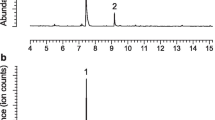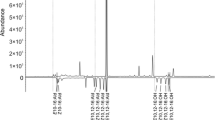Abstract
Four himachalene sesquiterpenes and (+)-γ-cadinene, previously identified as possible pheromone components from males of a North American population of Phyllotreta cruciferae Goeze (Coleoptera, Chrysomelidae), were tested for attractiveness in field trapping experiments in Hungary. A mixture of the four synthetic racemic himachalene derivatives and (+)-γ-cadinene from a botanical source was slightly attractive to beetles, but much more attractive when blended with the known host-plant-derived attractant allyl isothiocyanate. This result was consistent with a previous study in North America. In tests with optically pure synthetic compounds, a blend of the same himachalene enantiomers found from male beetles was equivalent to the corresponding blend of racemic compounds, whereas a blend of the opposite enantiomers was not active. Through subtraction tests, it was found that the single compound, (6R,7S)-2,2,6,10-tetramethylbicyclo[5.4.0.]undeca-9,11-diene [compound (+)-A in this study], was as active as the whole mixture, suggesting that this compound is the key pheromone component of the European population of P. cruciferae. During field trials, several congeneric species, including P. vittula, P. nemorum, P. nodicornis, and P. ochripes, also were caught, suggesting that the same compound(s) may be relatively widespread as pheromone components in this genus.







Similar content being viewed by others
References
R. J. Bartelt (1999) Sap beetles J. Hardie A. K. Minks (Eds) Pheromones of Non-Lepidopteran Insects Associated with Agricultural Plants CABI Publishing Wallingford, UK 69–89
R. J. Bartelt A. A. Cossé B. W. Zilkowski D. Weisleder F. A. Momany (2001) ArticleTitleMale-specific sesquiterpenes from Phyllotreta and Aphthona flea beetles J. Chem. Ecol. 27 2397–2423 Occurrence Handle10.1023/A:1013667229345 Occurrence Handle11789948
Bartelt R. J., Weisleder D., and Momany F. A. 2003. Total synthesis of himachalene sesquiterpenes of Aphthona and Phyllotreta flea beetles. Synthesis. 117–123
R. N. Campbell W. M. Colt (1967) ArticleTitleTransmission of radish mosaic virus Phytopathology 57 502–504
H. R. Dillard A. C. Cobb J. S. Lamboy (1998) ArticleTitleTransmission of Alternaria brassicola to cabbage by flea beetles (Phyllotreta cruciferae) Plant Dis. 82 153–157
P. Feeny K. L. Paauwe N. J. Demong (1970) ArticleTitleFlea beetles and mustard oils: host plant specificity of Phyllotreta cruciferae and P. striolata adults (Coleoptera: Chrysomelidae) Ann. Entomol. Soc. Am. 63 832–841
R. M. Giblin-Davis T. J. Weissling A. C. Oehlschlager L. M. Gonzalez (1994) ArticleTitleField response of Rhynchophorus cruentatus (Coleoptera, Curculionidae) to its aggregation pheromone and fermenting plant volatiles Fla. Entomol. 77 164–177
M. Glits (2000) Turnip yellow mosaic virus (in Hung.) M. Glits G. Folk (Eds) Kertészeti növénykórtan. (in Hung.) Mezögazda Kiadó Budapest
K. Görnitz (1956) ArticleTitleWeitere Untersuchungen über Insekten-Attraktivstoffe aus Cruciferen Nachr.bl. Dtsch. Pflanzenschutzd. N. F. 10 137–147
K. L. Hicks (1974) ArticleTitleMustard oil glucosides: Feeding stimulants for adult cabbage flea beetles, Phyllotreta cruciferae (Coleoptera: Chrysomelidae) Ann. Entomol. Soc. Am. 67 261–264
Z. Imrei M. Tóth (2002) ArticleTitleEuropean common cockchafer (Melolontha melolontha L.): Preliminary results of attraction to green leaf odours Acta Zool. Acad. Sci. Hung. 48 151– 155
K. Jaffé P. Sánchez H. Cerda J. V. Hernández R. Jaffé N. Urdaneta G. Guerra R. Martínez B. Miras (1993) ArticleTitleChemical ecology of the palm weevil Rhynchophorus palmarum (L.) (Coleoptera: Curculionidae): attraction to host plants and to a male-produced aggregation pheromone J. Chem. Ecol. 19 1703–1720 Occurrence Handle10.1007/BF00982302
P. Jourdheuil (1966) Sous-famille des Halticinae A. S. Balachowsky (Eds) Entomologie appliquée 1 l'agriculture, Vol. 1 Masson et Cie Éditeurs Paris 762–854
Z. Kaszab (1962) Chrysomelidae (in Hung.) V. Székessy (Eds) Fauna Hungariae, 63 Akadémiai Kiadó Budapest
R. J. Lamb (1989) ArticleTitleEntomology of oilseed Brassica crops Annu. Rev. Entomol. 34 211–229 Occurrence Handle10.1146/annurev.en.34.010189.001235
R. Markham K. M. Smith (1949) ArticleTitleStudies on the virus of turnip yellow mosaic Parasitology 39 330–342
K. Mori (2005) ArticleTitleSynthesis of (R)-ar-turmerone and its conversion to (R)-ar-himachalene, a pheromone component of the flea beetle: (R)-ar-himachalene is dextrorotatory in hexane, while levorotatory in chloroform Tetrahedron: Asymmetry 16 685–692 Occurrence Handle10.1016/j.tetasy.2004.11.077
Muto S., Bando M., and Mori K. 2004. Synthesis and stereochemistry of the four himachalene-type sesquiterpenes isolated from the flea beetle (Aphthona flava) as pheromone candidates. Eur. J. Org. Chem. 1946–1952
A. C. Oehlschlager R. N. B. Prior A. L. Perez R. Gries G. Gries H. D. Pierce S. Laup (1995) ArticleTitleStructure, chirality, and field testing of a male-produced aggregation pheromone of Asian palm weevil Rhynchophorus bilineatus (Montr.) (Coleoptera, Curculionidae) J. Chem. Ecol. 21 1619–1629 Occurrence Handle10.1007/BF02035156
R. C. Pandy S. Dev (1968) ArticleTitleStudies in sesquiterpenes. XXX. Synthesis of ar-himachalene and himachalanes Tetrahedron 24 3829–3839 Occurrence Handle10.1016/S0040-4020(01)92590-6
C. Peng M. J. Weiss (1992) ArticleTitleEvidence of an aggregation pheromone in the flea beetle, Phyllotreta cruciferae (Goeze) (Coleoptera: Chrysomelidae) J. Chem. Ecol. 6 875–884 Occurrence Handle10.1007/BF00988328
C. Peng R. J. Bartelt M. J. Weiss (1999) ArticleTitleMale crucifer flea beetles produce an aggregation pheromone Physiol. Entomol. 24 98–99 Occurrence Handle10.1046/j.1365-3032.1999.00113.x
K. A. Pivnick R. J. Lamb D. Reed (1992) ArticleTitleResponse of flea beetles, Phyllotreta spp., to mustard oils and nitriles in field trapping experiments J. Chem. Ecol. 18 863–873 Occurrence Handle10.1007/BF00988327
A. Reinecke J. Ruther M. Hilker (2002) ArticleTitleThe scent of food and defence: green leaf volatiles and toluquinone as sex attractant mediate mate finding in the European cockchafer Melolontha melolontha Ecol. Lett. 5 257–263 Occurrence Handle10.1046/j.1461-0248.2002.00318.x
A. Reinecke J. Ruther T. Tolasch W. Francke M. Hilker (2002) ArticleTitleAlcoholism in cockchafers: orientation of male Melolontha melolontha towards green leaf alcohols Naturwissenschaften 89 265–269 Occurrence Handle10.1007/s00114-002-0314-2 Occurrence Handle12146792
D. Rochat F. Akamou A. Sangare D. Mariau K. Mori (1995) ArticleTitlePiégeage de Rhynchophorus phoenicis (Coleoptera: Curculionidae) 1 l'aide de stéréo-isomeres de la pheromone d'agrégation C. R. Acad. Sci. Paris, Life Sci. 318 183–190
D. Rochat K. Mohammadpoor C. Malosse A. Avand-Faghih M. Lettere J. Beauhaire J. P. Morin A. Pezier M. Renou G. A. Abdollahi (2004) ArticleTitleMale aggregation pheromone of date palm fruit stalk borer Oryctes elegans J. Chem. Ecol. 30 387–407 Occurrence Handle10.1023/B:JOEC.0000017984.26917.52 Occurrence Handle15112731
J. Ruther M. Hilker (2003) ArticleTitleAttraction of forest cockchafer Melolontha hippocastani to (Z)-3-hexen-1-ol and 1,4-benzoquinone: application aspects Entomol. Exp. Appl. 107 141–147 Occurrence Handle10.1046/j.1570-7458.2003.00055.x
J. Ruther A. Reinecke K. Thiemann T. Tolasch W. Francke M. Hilker (2000) ArticleTitleMate finding in the forest cockchafer, Melolontha hippocastani, mediated by volatiles from plants and females Physiol. Entomol. 25 172–179 Occurrence Handle10.1046/j.1365-3032.2000.00183.x
J. Ruther A. Reinecke M. Hilker (2002) ArticleTitlePlant volatiles in the sexual communication of Melolontha hippocastani: response towards time-dependent bouquets and novel function of (Z)-3-hexen-1-ol as a sexual kairomone Ecol. Entomol. 27 76–83 Occurrence Handle10.1046/j.1365-2311.2002.0373a.x
K. Ryden (1989) ArticleTitleBrome mosaic virus, transmission and effect on yield in greenhouse trials J. Phytopathol. 124 256–258
G. Y. Sáringer (1998) Flea beetles of cruciferous plants—Phyllotreta spp. (in Hung.) G. Jenser Z. Mészáros G. Sáringer (Eds) A szántóföldi és kertészeti növények kártevöi Mezögazda Kiadó Budapest 212–214
Soroka, J. J., Bartelt, R. J., Zilkowski, B. W., Cossé, A. A. 2005. Responses of flea beetle Phyllotreta cruciferae to synthetic aggregation pheromone components and host plant volatiles in field trials 8:1829–1843. J. Chem. Ecol. (in press).
M. Subchev T. Toshova M. Tóth E. Voigt J. Mikulás W. Francke (2004) ArticleTitleCatches of vine bud moth Theresimima ampellophaga (Lep., Zygaenidae: Procridinae) males in pheromone traps: effect of the purity and age of baits, design, colour and height of the raps, and daily sexual activity of males Z. Angew. Entomol. 128 44–50 Occurrence Handle10.1046/j.1439-0418.2003.00805.x
M. Tóth Z. Imrei G. Szöcs (2000) ArticleTitleNon-sticky, non-saturable, high capacity novel pheromone trap designs for the western corn rootworm (Diabrotica virgifera virgifera, Coleoptera: Chrysomeldiae) and the cotton bollworm [Helicoverpa (Heliothis) armigera, Lepidoptera: Noctuidae] (in Hung.) Integr. Term. Kert. Szántóf. Kult. 21 44–49
M. Tóth É. Csonka F. Bakcsa P. Benedek (2004) ArticleTitleComparison of performance of trap designs baited with allyl isothiocyanate for the capture of flea beetles (Phyllotreta spp.) (Coleoptera, Chrysomelidae) (in Hung.) Növényvédelem 40 125–130
K. Vig (1996) ArticleTitleLeaf beetle fauna of the Praenoricum, Western Hungary (Coleoptera, Chrysomelidae sensu lato). (in Hung.) Praenorica Folia Hist.-Nat. 3 178
C. Vincent R. K. Stewart (1984) ArticleTitleEffect of allyl isothiocyanate on field behaviour of crucifer-feeding flea beetles (Coleoptera: Chrysomelidae) J. Chem. Ecol. 10 33–40 Occurrence Handle10.1007/BF00987641
Acknowledgements
The study was partially supported by grant OTKA T 043289 of the Hungarian Academy of Science. The authors are indebted to K. Vig for consultations in the species determination of captured specimens and to M. Szatmáry and B. Strasser from the Research Institute for Medical Plants (Budakalász, Hungary) for providing their experimental fields for some tests.
Author information
Authors and Affiliations
Corresponding author
Rights and permissions
About this article
Cite this article
Tóth, M., Csonka, É., Bartelt, R.J. et al. Pheromonal Activity of Compounds Identified from Male Phyllotreta cruciferae: Field Tests of Racemic Mixtures, Pure Enantiomers, and Combinations with Allyl Isothiocyanate. J Chem Ecol 31, 2705–2720 (2005). https://doi.org/10.1007/s10886-005-7621-y
Received:
Accepted:
Published:
Issue Date:
DOI: https://doi.org/10.1007/s10886-005-7621-y




